We use affiliate links to run our site. When you buy through links on our site, we may earn an affiliate commission, without any added cost to you. Learn more
Bees are an essential part of our ecosystem. They play a crucial role in pollinating plants, including many of the fruits, vegetables, and flowers that we rely on for survival.
Unfortunately, bees along with other pollinators are facing numerous challenges in recent years, including habitat loss, pesticide use, and disease. As a gardener, one way we can support these essential insects is by creating a bee garden.
A bee garden is a space designed to attract and support bees and other pollinators. It can be as small as a few pots on a balcony or as large as an entire backyard. By providing the right plants, water, and shelter, you can create a thriving habitat for bees and other pollinators.
In addition to supporting bees, a bee garden has numerous benefits for you and your community. It can provide a source of beauty, relaxation, and education, and it can also help increase the overall biodiversity in your area.
In this blog, we will cover the basics of setting up a bee garden and the different types of bees that you might encounter. We will also discuss the importance of supporting native bees and address common questions about bee gardening.
Whether you are a seasoned gardener or just getting started, creating a bee garden will be a rewarding and fulfilling experience for you.
Setting up a bee garden
Setting up a bee garden is a simple and rewarding project that can help support the health and well-being of bees and other pollinators. Here are some steps to get started:
- Choose the right location: Bees need access to sunlight and a source of nectar and pollen. Look for a sunny spot that is protected from strong winds and has a variety of flowering plants nearby.
- Plant the right flowers and plants: Bees are attracted to a wide range of flowers, including native plants and herbs. Some good options to consider include lavender, sunflowers, foxglove, and wildflowers. Plant a mix of annuals, perennials, and herbs to provide a continuous source of nectar and pollen throughout the growing season.
- Provide water and shelter: Bees need a source of water to drink and cool off. A shallow birdbath or a dish filled with pebbles and water will do the trick. They also need a place to rest and shelter from the elements. A bee house or a pile of twigs or leaves can provide a suitable habitat.
- Create a proper mix: In addition to bees, your garden can also support butterflies, hummingbirds, and other pollinators. Planting a mix of flowers with different colors, shapes, and bloom times can attract a variety of pollinators.
- Monitor and maintain your garden: Keep an eye on your garden to make sure it is meeting the needs of the bees. Deadhead spent flowers to encourage new blooms and remove any diseased or damaged plants. Avoid using pesticides and consider incorporating organic gardening practices.
Types of Bees:
Bees come in a wide variety of shapes and sizes, and they can be found all over the world. There are nearly 20,000 known species of bees. But here we will focus on 5 main types.
Some of the most common types of bees include bumblebees, honey bees, leafcutter bees, blue orchard bees, and mining bees. Each type of bee has its own unique characteristics and plays a vital role in the ecosystem.
Bumble Bee (Bombus ternarius):
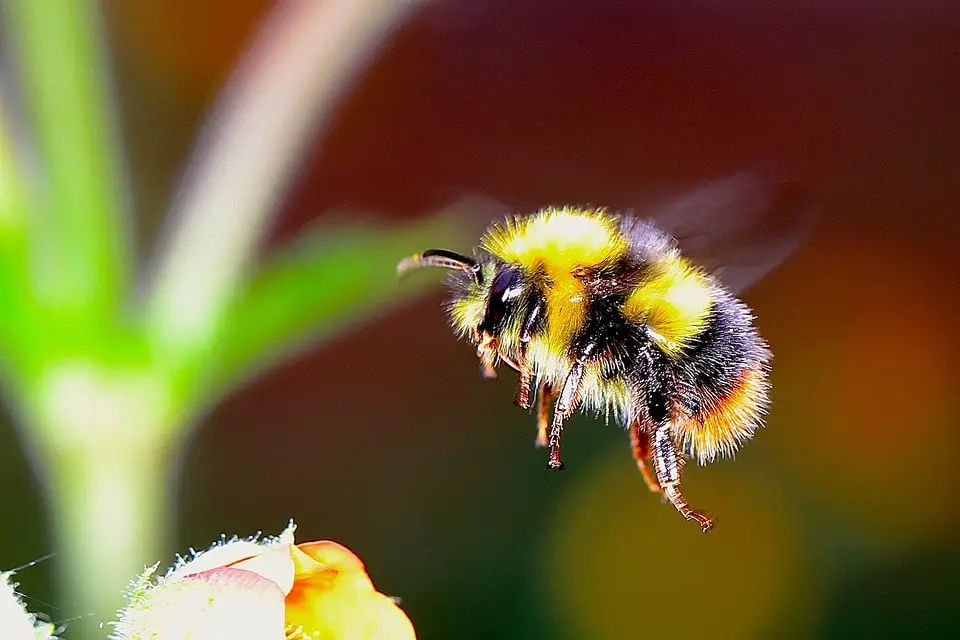
Bumblebees are larger in size (10 to 23 mm in length) and have a more rounded, fuzzy appearance. They have round bodies covered with soft hair making them appear and feel fuzzy. Because of the buzzing sound, they are called bumblebees.
They build their nests on the ground. Some species, such as Bombus impatiens, are used to pollinate greenhouse crops. Like their relatives the honeybees, bumblebees feed on nectar.
Honey Bee (Apis mellifera):

The first distinguishing feature of honey bees is they can produce and store honey and can create nests made of wax.
This European species is used for pollination and for honey, propolis, and beeswax production.
They live in large, organized colonies and are often kept by beekeepers for honey production and crop pollination.
Honey bees have a social hierarchy, with a queen bee responsible for reproduction, worker bees responsible for gathering food and caring for the young, and drones responsible for mating.
Bees are 10 to 15 mm in length and colonies survive winter on stored honey.
Leafcutter Bee (Megachile sp.):
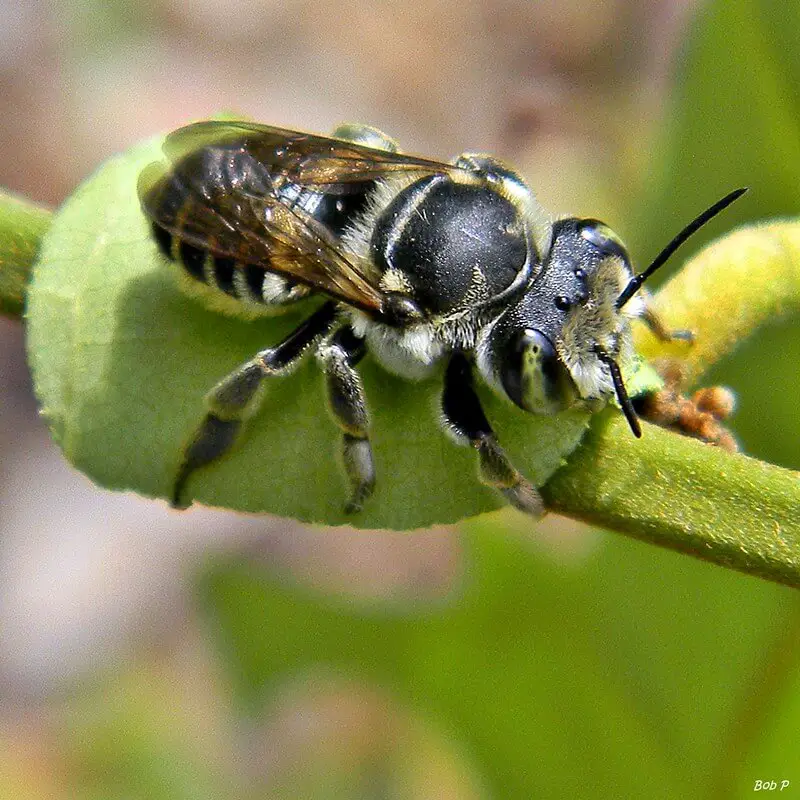
Leafcutter bees are solitary bees that get their name from their habit of cutting small circles or squares out of leaves to use as nest material.
They are 3 to 20 mm in length, and usually nest in cavities. Leafcutter bees use bits of leaves and flowers to wrap brood cells for their young.
They are important pollinators of a wide range of plants, including vegetables, fruit trees, and flowers.
Blue Orchard Bee (Osmia lignaria):
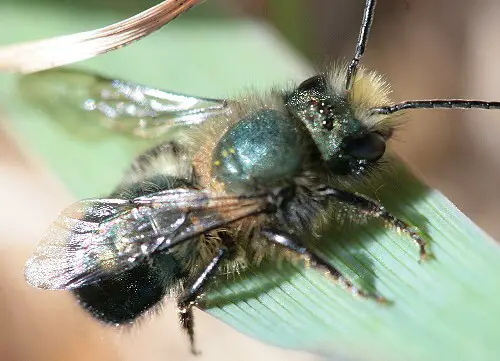
The blue orchard bee is a mason bee (11 to 15 mm in length) that uses mud to divide its brood cells.
It is a solitary bee that is native to North America. The bees are gentle and non-aggressive bees that are well-suited to urban environments.
Blue Orchard Bee belongs to the same family as leafcutter bees and is an important fruit pollinator. They are often used by farmers and home gardeners to increase crop yields.
Mining Bee (Andrena sp):
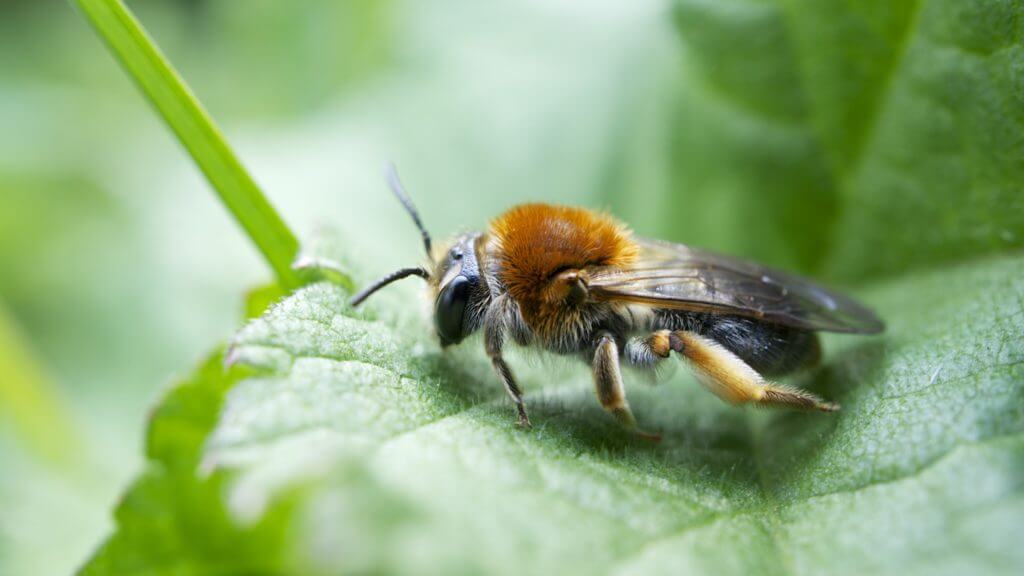
Mining bees are from 8mm to 17 mm in length. There are around 1300 species in this group. All species nest in the ground. Some species are important apple pollinators and can move more pollen than honey bees!
Mining bees are non-aggressive and are often overlooked due to their small size and underground nesting habits.
Basic Rules of Bee Gardening
When gardening for bees, here are a few general rules of thumb:
- Choose a range of flower shapes and colors to attract the most bee species. Bumblebees can easily collect pollen from complex flowers, while smaller bees appreciate simple flower shapes and a flat place to land.
- Plant season-long blooms to support garden bees from early spring until fall. Bees need a consistent source of nectar and pollen throughout the growing season. By planting flowers that bloom at different times, you can provide a continuous food source for bees
- Provide areas of undisturbed ground or vegetation for nesting sites. Many types of bees, including solitary bees, nest in the ground or in small cavities. By providing areas of undisturbed ground or vegetation, you can create a suitable habitat for these bees to nest.
- Bees and flowers have evolved in tandem, so make sure to choose non-hybrid natives. It will be attractive to native bees and provide a suitable food source.
- Plant in masses for efficient pollen collection. Sunny areas are the most attractive.
- Avoid using pesticides. Even some organic mixtures can harm insects. Consider using organic gardening practices or integrated pest management techniques to control pests and diseases.
- Provide a muddy area or shallow trough for water.
FAQs about bee gardening
How do I prevent and manage pests and diseases in a bee garden?
To prevent and manage pests and diseases in a bee garden:
• Plant a diverse range of flowers and plants to reduce the risk of pests and diseases.
• Use organic gardening practices or integrated pest management techniques to control pests and diseases.
• Regularly monitor your garden for signs of pests and diseases and remove any diseased or damaged plants.
• Keep your garden clean and tidy by removing weeds and debris.
How can I safely observe and interact with bees in my garden?
To safely observe and interact with bees in your garden:
• Avoid disturbing the bees when they are collecting nectar and pollen.
• Wear protective clothing, such as a hat, long sleeves, and gloves, when working in the garden.
• Keep a safe distance from the bees and do not try to touch or handle them.
• If you are allergic to bee stings, consider hiring a professional beekeeper to manage the bees in your garden.
Can I keep bees in my garden if I live in an urban area?
Yes, it is possible to keep bees in an urban garden. However, it is important to check with your local authorities to see if there are any regulations or restrictions on keeping bees in your area.
You may also need to obtain permission from your neighbors before setting up a beehive.
How much time and effort is required to maintain a bee garden?
The amount of time and effort required to maintain a bee garden will depend on the size and complexity of your garden. Basic maintenance, such as watering, weeding, and deadheading, will be required on a regular basis.
You may also need to spend additional time monitoring and managing pests and diseases, and providing food and shelter for the bees.
Can I have a bee garden if I have allergies to bee stings?
If you have allergies to bee stings, it is still possible to have a bee garden. However, you may need to take additional precautions to protect yourself.
Consider hiring a professional beekeeper to manage the bees in your garden, and make sure to keep a safe distance from the bees when they are active.
Can I harvest honey from my bee garden?
It is possible to harvest honey from your bee garden, but it requires a significant amount of time, effort, and knowledge.
If you are interested in harvesting honey, it is recommended that you seek the guidance of a professional beekeeper or join a beekeeping club to learn the proper techniques.
Conclusion:
In conclusion, a bee garden is a powerful and meaningful way to support the health and well-being of bees and other pollinators. These important insects play a vital role in the ecosystem and are facing numerous challenges, including habitat loss, pesticide use, and disease.
By creating a bee garden and providing the right plants, water, and shelter, you can make a tangible difference in the lives of bees and other pollinators.
In addition to supporting bees, a bee garden has numerous benefits for you and your community. It can provide a source of beauty, relaxation, and education, and it can also help increase the overall biodiversity in your area.
Whether you are a seasoned gardener or just starting out, creating a bee garden is a rewarding and fulfilling experience that can make a positive impact on the world around you.
So don’t hesitate, start your own bee garden today and make a difference in the lives of these essential insects.
Hope you like the article. You can read more about bees and other pollinators in this article. In the meantime, please help me create awareness about this topic by sharing it with others.
Happy Gardening!
Amazon and the Amazon logo are trademarks of Amazon.com, Inc, or its affiliates.

Hi there! My name is Prasenjit and I’m an avid gardener and someone who has grown a passion for growing plants. From my hands-on experience, I have learned what works and what doesn’t. Here I share everything I have learned.
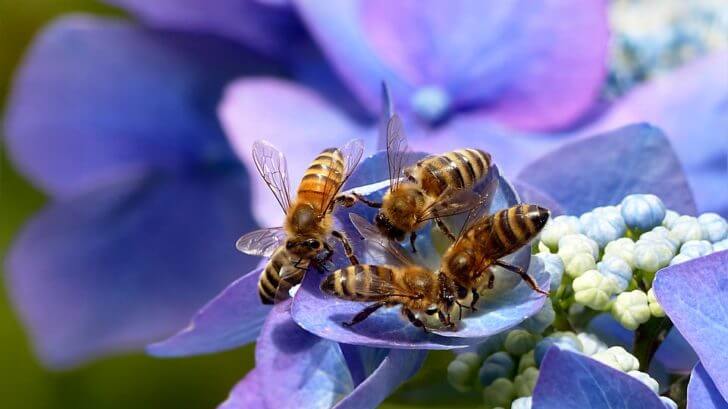
YE! This Is A Good Blog!